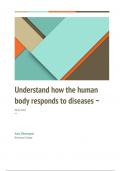Understand how the human
body responds to diseases ~
06.02.2023
─
Anna Dharmapuri
Richmond College
, 1
Where they both start from [initiation]:
The initiation of humoral and cellular immunity occurs in lymph nodes. Dendritic cells carry
bits of microbes with traffic through lymphatics to the lymph nodes. Lymphatics can also
carry bits of microbes into the lymph node as well. Dendritic cells will process the bits into a
format that the T cells can see. In the lymph node, the T cells that can see the bits will
interact with the dendritic cell and become activated. This is your cellular immune
response. Meanwhile, the free bits from the lymphatics can be picked up by B cells in the
lymph node. The B cells will process it in the same way that dendritic cells do and present
it. The activated CD4 T cells can then sense that presented piece of the microbe and license
the B cell to make antibodies. This is the humoral response. T cells will differentiate into
effector cells to combat the infection, central memory cells that reside in lymph nodes or
other lymphoid organs such as the spleen, and effector memory cells which will return to
the tissue where the infection began and reside there to react more quickly upon
reinfection. B cells that are secreting antibodies are called plasma cells and they are more
plentiful in bone marrow but can be found elsewhere as well. Both responses can be
systemic, with antibodies circulating in the blood along with T cells that seek out areas of
inflammation.
Cell-mediated:
Introduction -
Cell-mediated immune response:
● Uses T lymphocytes formed in the bone marrow and mature in the thymus gland.
● After maturation, the T lymphocytes circulate through the body in the blood until
they encounter an antigen for which they have a receptor. Then they are
stimulated to divide multiple times by mitosis and form clones.
● Three types of T lymphocytes:
● Killer cells - cause lysis of target cells, destroy virus-infected or cancer cells.
○ Helper cells – activate B-lymphocytes to produce antibodies.
○ Cells that suppress the immune response - stop the production of
antibodies, for instance.
Example:
The tuberculin skin test is a classic example of a CMI response. A characteristic CMI
response peaks at 24–48 h following exposure to the antigen.
, 2
Any antigens or pathogens that can bypass phagocytosis and other immune barriers are the
primary targets of cell-mediated immunity (CMI). A mechanism for cell-mediated cleaning is
its fundamental function. It is exceptionally good at killing cancerous cells, infected
bacterial cells, and even viral cells. However, it also contributes significantly to transplant
rejection. Helper T cells, also known as "Th" cells, identify and control the entire cell-
mediated response at the beginning of the response. A T cell response is activated in two
steps:
● Through their distinct T-cell receptors (TCR), naive CD4 T cells in the lymph
nodes follow infected cells with special antigen-presenting cells (APC). The first
step in activating the Th cell is this.
● The second step in activating Th cells is co-stimulatory molecules like B7, CD40,
and cytokines that activate T cells.
To eliminate the pathogens, this activated helper T cell now recruits other immune cells like
macrophages. In addition to being primarily involved in the activation of cytotoxic CD8 T
cells (also known as killer T cells, which is quite fitting!), activated macrophages are highly
effective at eliminating harmful pathogens. Apoptosis, or programmed cell death, is the
process by which activated CD8 T cells kill pathogens.
Relevance - Cell-mediated immune response refers to the actions of T-lymphocytes(T-cell)
which are a type of white blood cell. (B-cells are part of humoral immunity. There basically
are 4 types of T-cells.
1. Helper T-cells 2. Cytotoxic T-cells 3. Regulatory T-cells 4. memory T-cells
Helper T-cells secrete lymphokines which are signalling molecules that recruit and activate
other white blood cells to fight off infection. Helper T-cells are good at recognizing invaders
that are free floating in our body and ones that are reported to them by “antigen-presenting
cells.” If you lack these guys like in HIV/AIDS, your body’s ability to fight off pathogens is
severely compromised.
Cytotoxic T-cells will recognize cells that are not our own and are infected or damaged by
some exogenous pathogen, like a virus or bacteria, even cancerous cells. Especially vital
role in viral infections. Cytotoxic T-cells will kill cancerous cells and virally infected cells,
helping prevent that cell from releasing more viruses to infect other cells. If they fail
negative clonal selection (usually in the thymus gland) before they are released into the
body, they can recognize our antigens (self-recognition molecules) and attack our own
cells/body causing autoimmune disorders. Sometimes they fail to recognize cancerous
cells or infected cells. ***The thymus gland atrophies/regresses as you age, hence the T-
cell output is lower in the elderly. This is one of the reasons why we see a higher occurrence
of autoimmune diseases, cancer, and infections, especially viral infections in the elderly. ***




